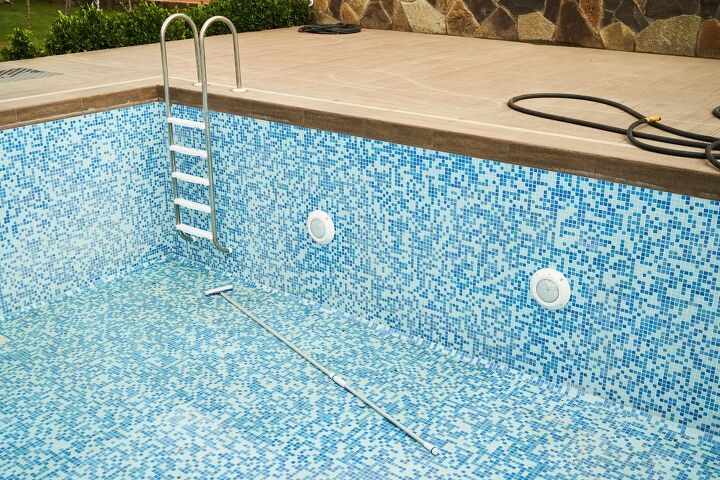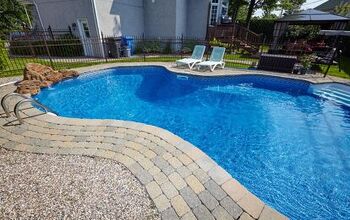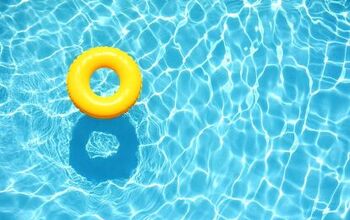How Long Can You Leave A Pool Empty? (Find Out Now!)

Pools from time to time will need maintenance. Most simple repairs and cleaning tasks can be fixed with the water still in the pool. However, for larger issues, you may need to drain it. If you have to call out a professional to drain your pool, you may be wondering if you can just leave it empty until the next time you need to use it.
If you leave your pool empty, the natural water table can put pressure on a pool with no water in it. This can result in structural damage, damage to the interior lining, or its support. You may have to drain your pool from time to time to repair it or clean it. However, you shouldn’t leave your pool empty for an extended period.
While it seems like it would require less upkeep to just leave your pool empty, it could cost you some expensive repairs in the long run! Pools need the weight of the water inside them to stay grounded. When you remove that water weight you can get some unwanted surprises.
Do You a Need Pool, Spa, or Hot Tub Contractor?
Get free, zero-commitment quotes from pro contractors near you.

What Happens to Your Pool When You Leave It Empty
The problems you may face by leaving your pool empty depend upon your pool type. Here are some things to look out for if you need to drain a concrete, above-ground, or fiberglass pool.
Concrete Pool
Older in-ground pools tend to be more susceptible to problems if left empty than modern ones. The surrounding soil can cause the walls to crack or cave in. You may also find damage to pool equipment such as lights and cleaning systems.
Newer concrete models are usually designed to hold up longer under pressure. Still, if the water table in your area is high (or a rainy season has loosened up the soil) your pool could begin to pop out of the ground.
Above Ground Pool
You may think an above-ground pool should fare better if it is left empty since you don’t have to worry so much about ground pressure and water tables. However, an above-ground pool has its own set of issues if left empty.
For an above-ground pool to have optimal stability it needs that weight of the water inside of it. Without this weight, your pool may break free from its track. Also, the liner could shrink and not fit back into the pool. An above-ground pool may also succumb to the elements if it is empty. This could cause structural damage as a result.
If you know your pool will remain unused for a while, it is best to leave water in the framework, winterize your pool, and leave it covered. If you find that rainwater is collecting on top of your pool cover and making it sag, you will want to pump the water off of your cover.
Fiberglass Pool
A fiberglass pool is the most complicated type of pool to drain without professional equipment. This is because the fiberglass material will float easily if given the chance. (This is why fiberglass boats are so good on water!)
You will need to support the frame of a fiberglass pool with braces when drained. If not, the lining can begin to crack under pressure. If you need to drain a fiberglass pool, you will want to call in a professional. The good news is that fiberglass pools also very rarely need to be drained.
Reasons to Drain Your Pool
While you don’t want to leave a pool empty any longer than is necessary, there are a few reasons you may need to drain your help.
A Deep Clean
Even if your water has been treated consistently to keep the right chemical balance, old water can become resistant to the same chemicals used again and again. This is why pool experts recommend that every five to seven years you give your pool a deep clean. For this process, you will drain all the old water out and start new. This gives both your water and chemicals a fresh start.
Pool Stains and Calcium Buildup
If your pool water can no longer stay at safe chemical levels you can get either calcium carbonate or calcium silicate. Either one may require you to drain your pool as they will cause a chemical imbalance in your water.
In addition to causing your pool water to be off-balance, calcium silicate can also stain your pool walls. This can be treated without draining the pool but may take months. A faster option is to drain the pool and clean the stains away.
Copper Stains
You may also notice green or brown stains on your pool walls left from copper. This copper presence can be caused by copper-based algaecides or low-quality pool salt. If you use chlorine to shock your pool you can actually make the stains darker instead of removing them. For copper stains, you will also need to drain your pool to effectively clean your pool walls.
Chlorine Lock
Chorine lock can occur from too much stabilizer in your water. When this occurs, your chlorine will have no effect on your water. This leaves room for algae and bacteria to grow. To minimize the presence of the stabilizer in the water, you will need to add fresh water to your pool. This process often requires you to drain your pool to achieve the correct chemical balance so that your chlorine can do its job.
Pool Repairs and Paint
Small pool repairs usually won’t require you to drain your pool. However, if you have to make major repairs or adjustments to your pool, or you need to paint it, you will need to drain your pool.
How to Winterize Your Pool Without Draining It
If you are trying to get your pool ready for winter, here are some steps you can take to close it down appropriately:
Step 1: Remove any pool accessories, such as floats, pool toys, and pool ladders
Step 2: Give your pool a thorough clean
Step 3: Test the water and adjust the chemical balance appropriately
Step 4: Lower the water level to just under the skimmer (2 or 3 inches at most)
Step 5: Store your equipment
Step 6: Shock your pool
Step 7: Add algaecide to your pool.
Step 8: Cover your pool.
Related Questions
Will cold weather cause a fiberglass pool to crack?
If your outside temperature is fluctuating between temperatures below and above freezing, this should not put a strain on your fiberglass pool. A concrete pool might be susceptible to cracks, but fiberglass is more resistant to temperature change than concrete is.
Should I remove pool steps for winter?
You will not want to leave access to your pool if it will be unsupervised. So, it is a good idea to remove pool steps and ladders from the pool if you will leave your pool unused for a while. You can lift out the ladder and store it until you will be using your pool again.
How much does it cost to drain a pool?
According to home.costhelper.com, it can cost between $150 and $800 to drain a pool, clean it, refill it, and add new chemicals to the water. This cost varies based on the size of your pool and how much work needs to be done.
Do You a Need Pool, Spa, or Hot Tub Contractor?
Get free, zero-commitment quotes from pro contractors near you.

Summing It Up
While it may be necessary from time to time to drain your pool, it is never a good idea to leave your pool empty for long. Leaving a pool empty could actually be more expensive in the long run than maintaining a pool full of water. If you are wanting to close your pool for the season, you can always leave water in it and “winterize” your pool.

Alex Praytor is a native Texan who got her degree in English Literature and decided to travel the globe. She finds the architecture and design of homes across cultures fascinating. In her spare time, she visits coffee shops with her family and creates projects for their own home. Alex enjoys sharing tips on how to keep repairs up to date while turning a house into a home.
More by Alex Praytor



























